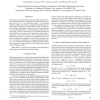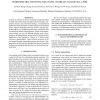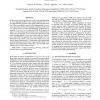ISBI
2009
IEEE
14 years 10 months ago
2009
IEEE
Understanding neural connectivity and structures in the brain requires detailed 3D anatomical models, and such an understanding is essential to the study of the nervous system. Ho...
ISBI
2009
IEEE
14 years 10 months ago
2009
IEEE
Fluorescence tomography has become increasingly popular for detecting molecular targets for imaging gene expression and other cellular processes in vivo in small animal studies. I...
ISBI
2009
IEEE
14 years 10 months ago
2009
IEEE
A panel of cell lines of diverse molecular background offers an improved model system for high-content screening, comparative analysis, and cell systems biology. A computational p...
ISBI
2009
IEEE
14 years 10 months ago
2009
IEEE
This paper describes and evaluates methods to detect pulmonary vein drainages and create detailed vessel trees of each drainage from contrast-enhanced magnetic resonance angiograp...
ISBI
2009
IEEE
14 years 10 months ago
2009
IEEE
In fluorescence microscopy the noise level and the photobleaching are cross-dependent problems since reducing exposure time to reduce photobleaching degrades image quality while ...
ISBI
2009
IEEE
14 years 10 months ago
2009
IEEE
Complementary to axial, lateral displacement and strain can provide important information on the biological soft tissues in all applications of elastography. In this paper, the ef...
ISBI
2009
IEEE
14 years 10 months ago
2009
IEEE
In this paper, we propose a data-driven approach that extracts prior information for segmentation of the left ventricle in cardiac MR images of transplanted rat hearts. In our app...
ISBI
2009
IEEE
14 years 10 months ago
2009
IEEE
Traditional fMRI analysis has focused on modeling temporal changes in BOLD signals on a voxel-by-voxel basis to infer brain activation. To incorporate spatial information, we have...
ISBI
2009
IEEE
14 years 10 months ago
2009
IEEE
We propose a reconstruction scheme adapted to MRI that takes advantage of a sparsity constraint in the wavelet domain. We show that artifacts are significantly reduced compared t...
ISBI
2009
IEEE
14 years 10 months ago
2009
IEEE



